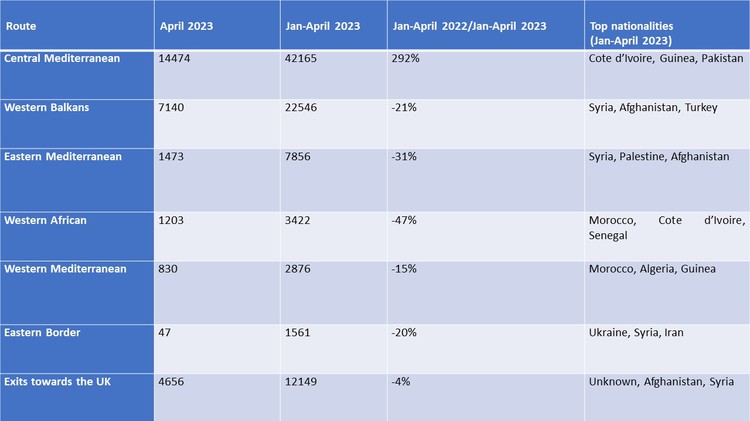Detections in Central Mediterranean at record level
In the first four months of the year the number of detections of irregular border crossings at EU’s external borders reached nearly 80 700, nearly 30% more than a year ago and the highest total for the January-April period since 2016, according to preliminary calculations*.
The number of irregular border crossings into the European Union across the Central Mediterranean in the first four months of 2023 quadrupled from the same period a year earlier, rising to the highest level since Frontex began collecting data in 2009, even as entries on all other major routes declined from a year ago.
Key findings
- In April, there were 25 200 detections of irregular border crossings, up 25% year-on-year.
- The Central Mediterranean route accounted for just over half of the irregular crossings into the EU so far this year.
- Entries on other migratory routes into the EU saw a decline.

Detections reported by national authorities on the Central Mediterranean route increased to almost 42 200 in January-April 2023. Criminal smuggling groups are increasingly using makeshift metal boats hastily assembled within hours of departure. Oftentimes fishing boats tow these metal boats closer to the Italian island of Lampedusa, their main destination.
This route accounted for just over half of irregular crossings into the EU so far this year. The Central Mediterranean drove all of the 28% rise in total detections so far this year; the rest of the top seven routes saw declines ranging from 7% to 47%.
Organised crime groups are taking advantage of political volatility in some departure countries to increase the number of migrants they smuggle across EU borders.
In response, more than 2 400 standing corps officers and Frontex staff are participating in operations to protect the EU’s external borders, as well as supporting member states and neighbouring countries facing various challenges at the EU’s external borders.
Although Syrians were the most frequently detected nationality so far this year, with 17% of the total on all migratory routes, their numbers have been mostly falling in recent months in favour of nationals from Sub-Saharan countries. The number of Ivorians rose eightfold and detentions of citizens of Guinea quintupled. Detections of Afghan citizens fell by just over half.
During January-April period, the Western Balkan route, which passes through countries including Serbia and Bosnia to the EU member states of Hungary and Croatia, was the second most active, with over 22 500 detections, down 21% from a year earlier.
Countries in the region have been aligning their visa policies with the EU and Hungary has reinforced its border control capacity, contributing to the decline.
Note: The preliminary data presented in this statement refer to the number of detections of irregular border-crossing at the external borders of the European Union. The same person may cross the border several times in different locations at the external border.





